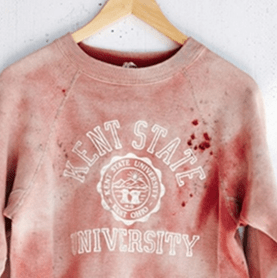 The last few months have seen a cornucopia of PR disasters. My friend and colleague Rob Deigh sent around three links highlighting some embarrassing gaffes in the fashion industry. Then there was a seriously flawed ad campaign for Malaysian Airways. Each in its own way showed more than bad taste—every one displayed gross tone deafness and a lack of cultural sensitivity.
The last few months have seen a cornucopia of PR disasters. My friend and colleague Rob Deigh sent around three links highlighting some embarrassing gaffes in the fashion industry. Then there was a seriously flawed ad campaign for Malaysian Airways. Each in its own way showed more than bad taste—every one displayed gross tone deafness and a lack of cultural sensitivity.
The first example puts Urban Outfitters in the hot seat for creating a ”vintage Kent State sweatshirt” complete with bloody red paint, as if to mock the fact that four people were killed in 1970 during Vietnam-era campus protests. There was Zara’s children’s T-shirt will a yellow star that looked like the prison uniforms worn in the German concentration camps. Perhaps the weirdest of all was the Colombian Women’s Cycling team’s flesh colored uniforms that revealed way too much of the team’s lower extremities. And the saddest was Malaysian Airways bucket list campaign which asked customers to name the destinations they wanted to go to before they die.
PR or Poor Judgment?
The essential question isn’t just, “Where were the PR folks?” Rather, it’s “What happened to common sense, perspective, an understanding of history, and cultural sensitivity?” All appear to have been absent in each of these cases. Or were they?
In our overstimulated, over-messaged and just plain overwhelming communications landscape, pushing the envelope and going for the shock factor seems to be the only strategy that some can imagine to cut through the clutter to get their brand noticed. We now have a culture of apology: “I made a mistake, I deeply regret it, and I’m sorry.” The posture seems to accept that we forgive without question and move on until it happens again (then repeat the cycle). If public relations teams were involved in this, their pleas to stop the insanity fell on deaf ears. Far more sinister for this profession is the thought that perhaps the PR folks encouraged it as an opportunity for publicity (in keeping with the “no such thing as bad publicity” school of thought). After all, it worked because lots of people wrote about it, including me in this blog post.
The challenge with shock PR is that it is unclear how much it helps a brand over the long-term. Effective branding is about creating trust, not offending part or all of your customer base. For me, it makes me think twice about Urban Outfitters and Zara, both places I have shopped. With regard to the Colombia Cycling Team, I first thought the big reveal was a joke, But apparently they’ve been wearing these uniforms for quite some time now. And that’s just plain stupid.
As for Malaysian Airways, the bucket list ad was one they used in the past. No one bothered to make the connection that in a year with two Malaysian air disasters and the accompanying loss of more than 500 lives, now was not a good time for that campaign. Shouldn’t their real focus be on demonstrating that it is safe to fly this airline?
For those of us who manage brands and seek to engage customers effectively, these examples are a cautionary tale. Before launching any campaign, think about the ramifications. If you reference a historical event, such as Kent State, make sure you really understood what actually happened there. Test, test, and test. And make sure that your teams are rich with diversity, bringing differing perspectives and cultural knowledge to the table.
It takes years to build a reputation. It can take just one mistake to destroy it.

